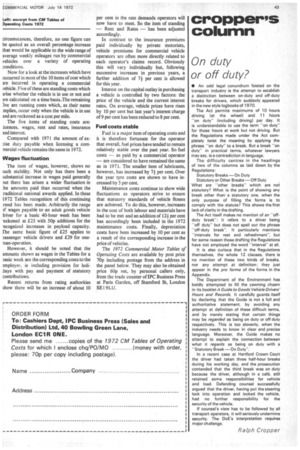cropper's column
Page 43

If you've noticed an error in this article please click here to report it so we can fix it.
On duty or off duty?
• An odd legal conundrum foisted on the transport industry is the attempt to establish a distinction between on-duty and off-duty breaks for drivers, which suddenly appeared in the new style logbooks of 1970.
The Act permits maximums of 10 hours driving (at the wheel) and 11 hours "on duty" (including driving) per day. It is understandable to use the term -on duty" for those hours at work but not driving. But the Regulations made under the Act completely twist the meaning by applying the phrase "on duty" to a break. But a break "on duty" in practical terms, whatever lawyers may say, is a contradiction in language.
The difficulty centres in the headings of two of the columns as laid down by the Regulations: Statutory Breaks —On Duty Statutory or Other Breaks— Off Duty What are "other breaks" which are not statutory? What is the point of showing any break other than' a statutory one, when the only purpose of filling the forms is to comply with the statute? This shows the first lack of clarity in the drafting.
The Act itself makes no mention of an -offduty break": it refers to a driver being "off duty" but does not spell out the phrase "off-duty break". It particularly mentions "intervals for rest and refreshment", but for some reason those drafting the Regulations have not employed the word "interval" at all.
It is also curious that in the Regulations themselves, the whole 12 clauses, there is no mention of these two kinds of breaks, nor any attempt at definition: they just appear in the pro forma of the forms in the Appendix.
The Department of the Environment has boldly attempted to fill the yawning chasm in its booklet A Guide to Goods Vehicle Drivers' Hours and Records. It carefiltIly guards itself by declaring that the Guide is not a full and authoritative statement, by avoiding any attempt at definition of these difficult terms, and by merely stating that certain things may be regarded as being on duty or off duty respectively. This is too slovenly, when the industry needs to know in clear and precise language. Moreover, the Guide makes no attempt to explain the connection between what it regards as being on duty with a -Statutory Break—On Duty".
In a recent case at Hertford Crown Court the driver had taken three half-hour breaks during his working day, and the prosecution contended that the third break was on duty because the driver, although in a café, still retained some responsibilities for vehicle and load. Defending counsel successfully argued that the driver, having put the steering lock into operation and locked the vehicle, had no further responsibility for the security of the vehicle.
If counsel's view has to be followed by all transport operators, it will seriously undermine security. The DoE's interpretation requires major challenge.
Ralph Cropper






























































































